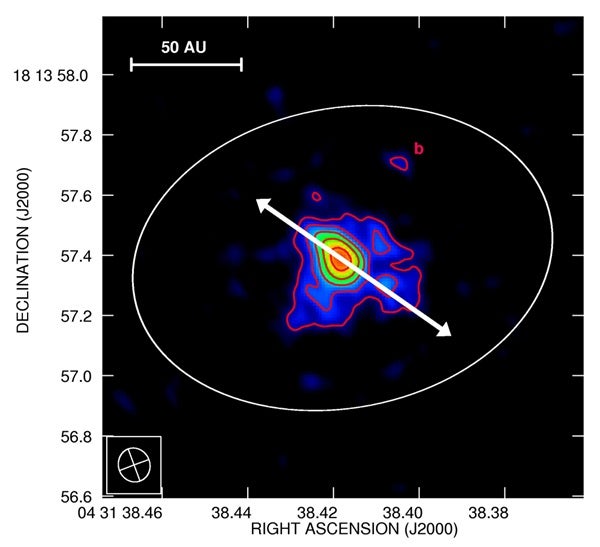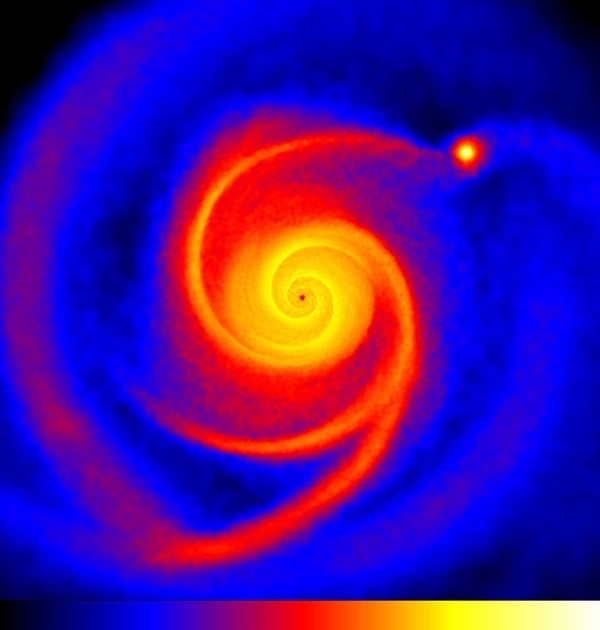Using radio observatories in the UK and US and computer simulations, a team of astronomers has identified the youngest forming planet yet seen. Team leader Jane Greaves of the University of St. Andrews will discuss this new protoplanet in her talk at the RAS National Astronomy Meeting in Belfast on Wednesday April 2.
Taking advantage of a rare opportunity to use the Very Large Array (VLA) of radio telescopes in the U.S. with the special addition of an extra telescope 50 kilometers away, the team studied the disk of gas and rocky particles around the star HL Tau. This star is thought to be less than 100,000 years old (by comparison the Sun is 4,600 million years old) and lies in the direction of the constellation of Taurus at a distance of 520 light-years. The disk around HL Tau is unusually massive and bright, which makes it an excellent place to search for signs of forming planets.
The VLA gives very sharp images of HL Tau and its surroundings. The team studied the system using radio emission at a wavelength of 1.3 cm, specifically chosen to search for the emission from super-large rocky particles about the size of pebbles. The presence of these pebbles is a clue that rocky material is beginning to clump together to form planets.
In the UK, scientists used the MERLIN array of radio telescopes centered on Jodrell Bank in Cheshire, to study the same system at longer wavelengths. This allowed the astronomers to confirm that the emission is from rocks and not from other sources such as hot gas. Jodrell Bank scientists Anita Richards and Tom Muxlow analyzed the data.
Greaves comments, “We see a distinct orbiting ball of gas and dust, which is exactly how a very young protoplanet should look. In the future, we would expect this to condense out into a gas giant planet like a massive version of Jupiter. The protoplanet is about 14 times as massive as Jupiter and is about twice as far from HL Tau as Neptune is from our Sun.”
Richards adds, “The new object, designated HL Tau b, is the youngest planetary object ever seen and is just 1 percent as old as the young planet found in orbit around the star TW Hydrae that made the news last year. HL Tau b gives a unique view of how planets take shape, because the VLA image also shows the parent disk material from which it formed.”
Team member Ken Rice of the University of Edinburgh ran a computer simulation to find out how such a massive protoplanet could form. His animation shows a very similar body condensing out of a disk with similar properties to that actually observed around HL Tau. The planet forms because of gravitational instability in the disk, which is about half as massive as the star itself. This allows small regions to separate out and cool down into self-contained structures. This instability mechanism has been controversial, but the simulated and real data are such a good match that it seems the mechanism really does operate in nature.
Rice comments, “The simulations were as realistic as we could make them and we were delighted that the results compare so well with the observations.”
One intriguing property is that XZ Tau, another young star in the same region, may have passed near HL Tau about 1,600 years ago. Although not required for planet formation, it is possible that this flyby tweaked the disk and helped it become unstable. This would be a very recent event in astronomical terms. Whether the proto-planet formed in only the last few hundred years, or sometime in the 100,000 years since the birth of HL Tau, the images provide a unique view of planet formation in action, and the first picture of a protoplanet still embedded in its birth material.











